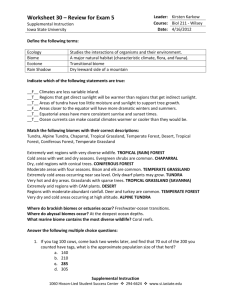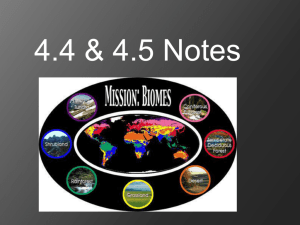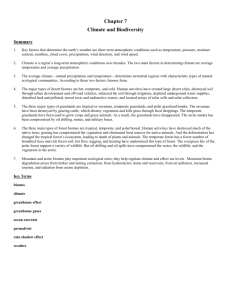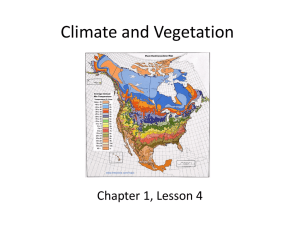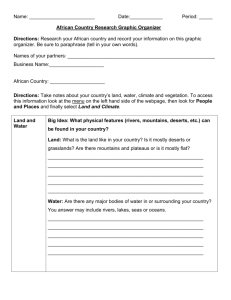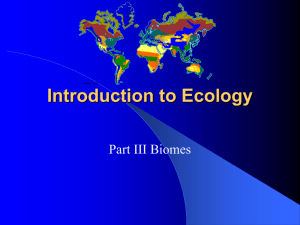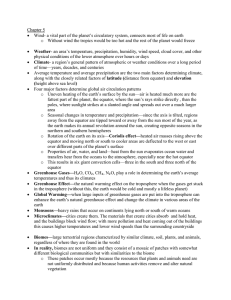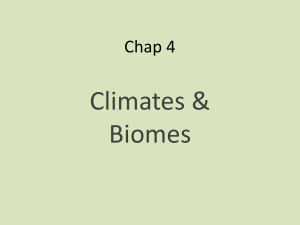Geographic Ecology, Climate, and Biomes
advertisement
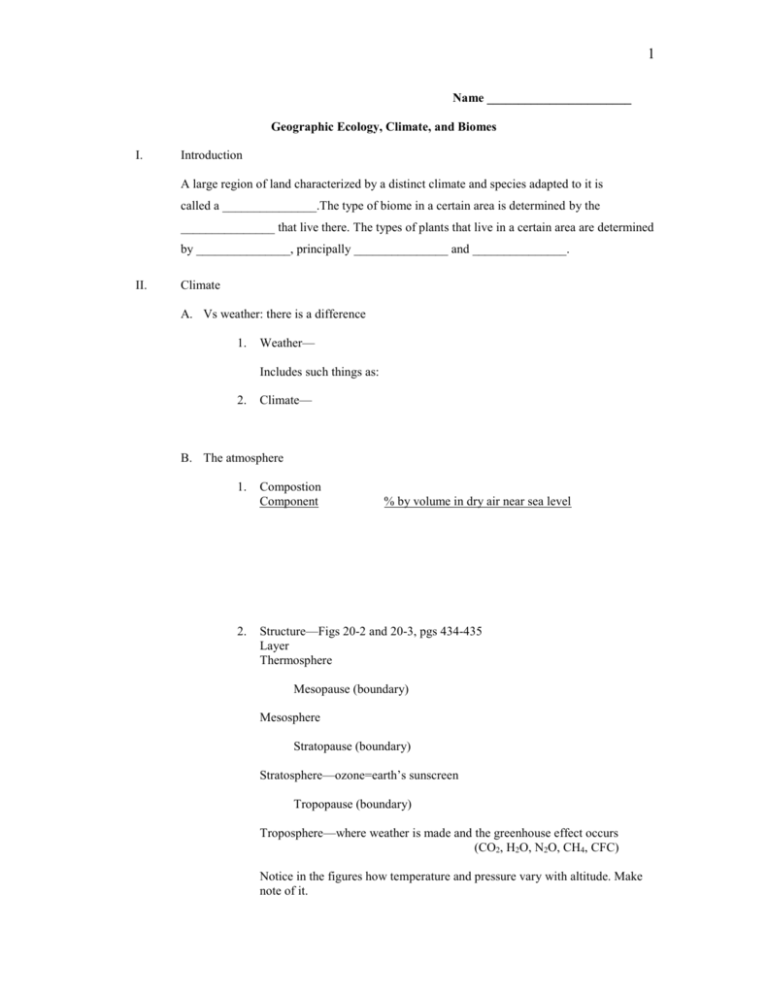
1 Name _______________________ Geographic Ecology, Climate, and Biomes I. Introduction A large region of land characterized by a distinct climate and species adapted to it is called a _______________.The type of biome in a certain area is determined by the _______________ that live there. The types of plants that live in a certain area are determined by _______________, principally _______________ and _______________. II. Climate A. Vs weather: there is a difference 1. Weather— Includes such things as: 2. Climate— B. The atmosphere 1. 2. Compostion Component % by volume in dry air near sea level Structure—Figs 20-2 and 20-3, pgs 434-435 Layer Thermosphere Mesopause (boundary) Mesosphere Stratopause (boundary) Stratosphere—ozone=earth’s sunscreen Tropopause (boundary) Troposphere—where weather is made and the greenhouse effect occurs (CO2, H2O, N2O, CH4, CFC) Notice in the figures how temperature and pressure vary with altitude. Make note of it. 2 C. More about weather 1. Weather is a direct result of… 2. Fronts a. cold front—advancing… warm front—advancing… b. Why do fronts often produce rain? cold air is ____________, so as it advances, it pushes air ahead of it _____________. This rising air _____________ and ___________, causing water to _____________, leading to rain. 3. Atmospheric pressure a. caused by air molecules striking things; measured with a barometer b. Uneven heating of the earth’s surface leads to air pressure differences, which causes a lot of the weather we see, particularly ____________. c. Low pressure vs high pressure Condition low pressure high pressure Vertical air movement Horizontal air movement General weather 4. Humidity—a measure of the amount of ____________________ in the air. Effects human comfort. a. relative humidity- a percentage of how much water a parcel of air contains compared to how much it COULD contain. Greatly dependent on temperature, so it is often misunderstood. b. Dewpoint—temperature at which… Gives a much more accurate picture of what it “feels like” outside < 60 oF= 60-70 oF= >70 o F= >80 oF= D. Things that effect climate (especially temperature and precipitation) 1. Uneven heating of the earth’s surface a. sun angle: the sun shines directly on the__________________, but it’s energy is dispersed as you move ________________ due to the _______________ of the earth. b. The phenomena observed in letter “a” above is accentuated by the tilt of the earth on its axis: _______ o. This creates the ________________. 3 2. Global circulation of air See Fig 6-8 on pg 107. a. The earth spins faster at the ____________________ than at the _______________. As a result, air is deflected in predictable ways as it moves across the earth’s surface. This creates ____________________ winds and the is called the ____________________ ______________. b. As air rises and falls, it creates six convection cells called ___________ cells that distribute heat and moisture over the earth’s surface. 3. Long-term variations in solar radiation 4. Ocean currents a. b. also help mix and distribute nutrients c. upwelling—when persistent offshore winds push surface water away and brings up cold, nutrient rich water. Fig 6-11, p 108 5. El Nino/Southern Oscillation (ENSO) and La Nina, Fig 6-12, pg 108 a. Normally (La Nina), winds off South America blow ______________ (westward) creating upwelling along the western South American coast = __________ fishing. b. Every 3-7 years, the normal winds slacken or reverse, causing 1. 2. 3. 4. 6. global weather effects. See Fig 6-13, p 109 Topography and other Microclimates a. the rainshadow effect (Fig 6-15, pg 110): moist air hits a mountain range, it is forced to ____________, which causes it to __________ and water to _______________. This creates _____________ conditions on the _______________ side of the mountain. On the far side of the mountain (_______________), there is less moisture available, and is considerably _______________. This is how some _______________ are formed. 4 b. The Urban Heat Island Cities tend to hold heat in the materials used to build them, so they are _______________ in the winter and _______________ in the summer. c. Mountain slopes In the northern hemisphere, the _______________ side of a mountain gets more sun and is therefore warmer and drier. d. Moderation by water Water has a very high _______________________, which means it is slow to warm up or cool down. As a result, areas near water tend to be influenced by it. Miami vs. Miami Beach: San Fransicko: Jolly Olde England: III. Deserts A. General characteristics 1. precipitation: 2. location: 3. land coverage: 4. vegetation: 1. 2. 3. 4. tropical temperate cold semi B. Types ECOTONE C. Organism adaptations 1. plants a. leaves: b. flowers: c. roots: 5 2. d. photosynthesize: e. thorns & toxins animals a. activity: b. skin/covering: c. water use: d. ears: D. Human impact 1. 2. IV. Are deserts tough or fragile? a. growth: b. nutrient cyles: c. species diversity: d. water: e. recovery time: Water a. Salinization b. depletion of aquifers 3. Mining: 4. Storage: 5. solar cells: Grasslands and Chaparral A. General grassland characteristics 1. precipitation: 2. vegetation: 3. seasonal drought, fires, and grazing herbivores 6 B. Types 1. 2. 3. 4. SAVANNA/ Tropical grassland a. alternating… b. fires c. occasional: d. grazing hoofed mammals temperate grassland a. a.k.a b. soil: c. winter: summer: TUNDRA/polar grassland a. land coverage: b. climate: c. permafrost: d. vegetation: e. fragile f. soil: Alpine tundra Similar to arctic tundra, found on mountain slopes below snow line, No permafrost C. Human impact on grasslands 1. 2. Conversion to cropland a. Erosion and desertification: b. release of CO2 from agriculture damage to tundra from mining activities D. CHAPPARAL/ temperate shrubland 1. climate: 2. vegetation: 3. fires & flooding 7 V. Forests A. Enough precipitation to: B. Types 1. 2. 3. 4. 5. Tropical Rain Forest a. Temp: b. Precipitation: c. Biodiversity: d. Vegetation: e. Nutrients: f. Soil: g. Land coverage: TROPICAL DECIDUOUS FOTEST/ tropical seasonal forest/ tropical monsoon forest a. climate: b. vegetation: Temperate deciduous forest a. Climate: b. soil: c. vegetation: d. biodiversity: TAIGA/EVERGREEN CONIFEROUS FOREST/ BOREAL FOREST a. Climate: b. biodiversity: c. vegetation: d. soil: e. land coverage: Temperate rain forest/coastal coniferous forest a. climate: b. location: 8 c. vegetation: C. Human impact on forests Deforestation for agriculture, timber, livestock, urbanization, monoculture (TDF) VI. Mountains A. General characteristics 1. going up = going north 2. the snow line & climate control 3. soil: 4. biodiversity: 5. forests are here B. Human impact 1. timber 2. mining 3. dams/reservoirs 4. overuse 5. ORVs 6. UV radiation: VII. Latitude and altitude variations

